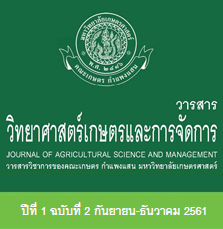DNA fingerprint analysis and pathogenicity of cassava dry rot and black rot caused by Fusarium solani and Neoscytalidium hyalinum
Keywords:
Dry rot, Black rot, Fusarium solani, Neoscytalidium hyalinum, ISSRAbstract
Dry rot and black rot diseases are the main problem of cassava production in Thailand. Dry rot and black rot diseases caused by 2 fungal genera such as Fusarium sp. and Neosytalidium sp. respectively. This study, the disease sample collection was conducted from Rayong province and Tak province, then the samples were isolated by Tissue transplanting method. Based on morphological characteristics, 2 species were identified including F. solani and N. hyainum. DNA fingerprint analysis of F. solani and N. hyalinum isolates were done by using 7 primers including P3: GTG(CGA)5, P4: GCG(CGA)5, P5: AAT(CGA)5 ,P6: ATC(CGA)5, (GTG)5, (CGA)5 and (CAG)5 . The results revealed that these fungal isolates were genetic diversity in each locality. However, some isolates of these species were similar although collected from different geographical area. Moreover, the pathogenicity of 2 fungal species with 4 isolates including RYG2, TAK14, RYG5, TAK19 were evaluated on 13 cultivars of cassava. The pathogenicity test indicated Rayong 72 was low percentage of disease index after inoculation with 4 fungal isolates. Moreover, the disease virulence was different on cultivars when inoculated by fungal isolates. These results revealed that there was difference or genetic diversity in fungi






